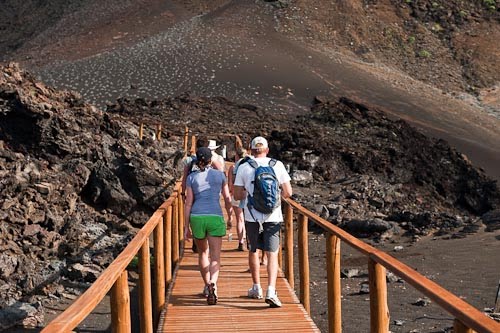While we are eating lunch Queen of Galapagos has moved from North Seymour to Bartolomé Island. To get there she sailed between the islands of Daphne Minor and Daphne Major, the second of which has been made famous by the publication of Beak of the Finch by Jonathan Weiner. This book tells the fascinating story of how and why an English couple, Peter and Rosemary, Grant have been regularly returning for 25 years to this tiny island. They have been researching the many different species of the famous Darwin’s finches to be found here.
We reach Bartolomé Island at around 3pm and shortly after the anchor has fallen into the water the yacht’s efficient crew have launched the pangas (tenders to you and I!).
This island is possibly the most photographed landscape in the whole of the Galapagos and it is easy to see why. It rises starkly from the ocean, a barren volcanic upthrusting onto which very little in the way of vegetation has settled.
The island maybe barren but the waters around it are teaming with sea life and we are quickly rewarded when we spotted our first of the Galapagos Penguin, the smallest penguin in the world. It is bizarre that here on the Equator is a species of the flightless bird whose usual habitat is Antarctica.
We land on the rocks and begin our trek up to the island’s peak atop of which is a small lighthouse.
JC still fastidiously dressed in freshly pressed shorts, neatly trimmed beard, gold rimmed aviator sunglasses and the ubiquitous Panama hat is in his element. What he does not know about volcanic eruptions and the complex landscape it creates is simply not worth knowing.
He shows us Spatter Cones where lava leftovers have been thrown into the air, cooling as they fall to the ground. He points out Tuff Cones created when copious quantities of ash as opposed to lava are deposited by eruptions. He explains the way lava falls down the mountainside leaving a trail of that looks like the mountain has been smeared in liquid caramel.
On the moon like landscape one plant that is serious about survival is the Lava Cactus. This plant produces prickly green tubes which turn first a golden yellow then brown and finally grey before they drop off to create fertiliser for the new life. Another hardy plant, this time must smaller and one that flowers is the Galapagos Petunia.
Reaching the top, the view is stunning, far below us, Queen of Galapagos lies quietly at anchor in the bay as the sun sets behind her. We all scamper down the mountainside, someone has mentioned the chance of a cool beer back on board and with this thought in mind we make our way back down the arid slopes.
Queen of Galapagos is available for charter through Robert Shepherd at Edmiston

